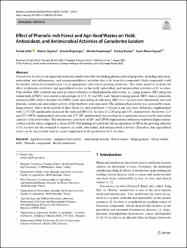| dc.contributor.author | Atila, Funda | |
| dc.contributor.author | Öğütçü, Hatice | |
| dc.contributor.author | Bilginoğlu, Emine | |
| dc.contributor.author | Kazankaya, Ahmet | |
| dc.contributor.author | Kumar, Pankaj | |
| dc.contributor.author | Fayssal, Sami Abou | |
| dc.date.accessioned | 2025-05-21T11:18:50Z | |
| dc.date.available | 2025-05-21T11:18:50Z | |
| dc.date.issued | 2024 | en_US |
| dc.identifier.citation | Atila, F., Ogutcu, H., Bilginoglu, E., Kazankaya, A., Kumar, P., & Fayssal, S. A. (2024). Effect of phenolic-rich forest and Agri-food wastes on yield, antioxidant, and antimicrobial activities of Ganoderma lucidum. Biomass Conversion and Biorefinery, 14(20), 25811-25821. | en_US |
| dc.identifier.issn | 21906815 | |
| dc.identifier.uri | https://10.1007/s13399-023-04708-6 | |
| dc.identifier.uri | https://hdl.handle.net/20.500.12513/7358 | |
| dc.description.abstract | Ganoderma lucidum is an important medicinal mushroom with outstanding pharmaceutical properties, including anticancer, antioxidant, anti-inflammatory, and immunomodulatory activities due to its bioactive compounds. Such compounds could be suitably enhanced in mushrooms via an appropriate selection of growing substrates. This study aimed to evaluate the effect of phenolic-rich forest and agricultural wastes on the yield, antioxidant, and antimicrobial activities of G. lucidum. Oak sawdust (OS) (control) was used as a basal substrate to which phenolic-rich wastes, i.e., grape pomace (GP) and green walnut hulls (GWH), were mixed in percentages of 12.5, 25, and 50% each. Spawn running period (SRP), time to primordia initiation (DPI), time to first harvest (DFH), yield, and biological efficiency (BE) of G. lucidum were determined, and total phenolic content and antioxidant activity of the fruitbody were measured. The antimicrobial activity was assessed by examining extracts’ effect on the growth of three Gram (+) and four Gram (−) bacteria and one yeast. Substrates supplemented with 12.5% GP significantly increased the yield and BE of G. lucidum (112.16 g/kg and 33%, respectively). Moreover, 12.5 and 25% GWH-supplemented substrates and 25% GP-supplemented ones resulted in a significant increase in the antioxidant capacity of the fruit bodies. The mushrooms cultivated on GP- and GWH-supplemented substrates exhibited higher antimicrobial activity when compared to those of OS. Our findings revealed that the incorporation of GP in the growing substrate of G. lucidum has the potential to improve its yield, antioxidant, and antimicrobial activities. Therefore, this agricultural waste can be successfully used as a good supplement in the production of G. lucidum. © The Author(s), under exclusive licence to Springer-Verlag GmbH Germany, part of Springer Nature 2023. | en_US |
| dc.language.iso | eng | en_US |
| dc.publisher | Springer Science and Business Media Deutschland GmbH | en_US |
| dc.relation.isversionof | 10.1007/s13399-023-04708-6 | en_US |
| dc.rights | info:eu-repo/semantics/openAccess | en_US |
| dc.subject | Agri-food Wastes | en_US |
| dc.subject | Antimicrobial Activity | en_US |
| dc.subject | Antioxidant Activity | en_US |
| dc.subject | Forest Wastes | en_US |
| dc.subject | Grape Pomace | en_US |
| dc.subject | Green Walnut Hulls | en_US |
| dc.subject | Phenolic Compounds | en_US |
| dc.subject | Reishi Mushroom | en_US |
| dc.title | Effect of Phenolic-Rich Forest and Agri-Food Wastes on Yield, Antioxidant, and Antimicrobial Activities of Ganoderma Lucidum | en_US |
| dc.type | article | en_US |
| dc.relation.journal | Biomass Conversion and Biorefinery | en_US |
| dc.contributor.department | Ziraat Fakültesi | en_US |
| dc.contributor.authorID | Hatice Öğütçü / 0000-0001-7100-9318 | en_US |
| dc.contributor.authorID | Ahmet Kazankaya / 0000-0002-1081-4281 | en_US |
| dc.identifier.volume | 14 | en_US |
| dc.identifier.issue | 20 | en_US |
| dc.identifier.startpage | 25811 | en_US |
| dc.identifier.endpage | 25821 | en_US |
| dc.relation.publicationcategory | Makale - Uluslararası Hakemli Dergi - Kurum Öğretim Elemanı | en_US |


















